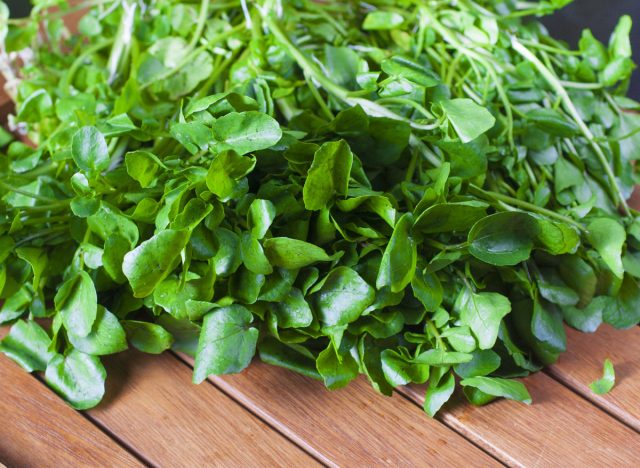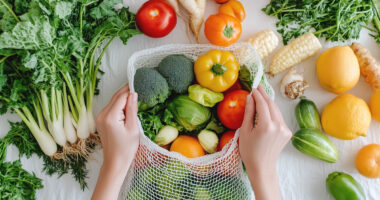We all know by now that leafy greens are some of the healthiest foods we can eat. In general, these vegetables—which include things like spinach, kale, cabbage, etc.—have been linked to slowing cognitive decline, reducing the risk of heart disease, and even lowering your risk of certain cancers. Beyond these general health benefits, some leafy greens are much richer in nutrients than their peers, which leads us to the question of which leafy greens are the absolute healthiest for us to eat.
The CDC (Centers for Disease Control) released a report in 2014 that ranked 47 fruits and vegetables according to their nutrient density. These items were chosen based on being strongly associated with the reduction of chronic diseases, as well as containing 10% or more of your daily value of 17 different nutrients in a serving.
After closely looking at these criteria, the CDC then gave each item a “nutrient-density” score and ranked them in order of most to least dense. Although the report includes all types of fruits and vegetables (green leafy, yellow/orange, citrus, etc.), we took a closer look at leafy green vegetables specifically.
The following 18 leafy green vegetables are ranked in order of how they’re scored in the CDC report, with the #1 being the most nutrient-dense and possibly the most surprising winner. Read on to learn more, and for more healthy eating tips, check out The 8 Healthiest Nuts You Can Eat.
Iceberg Lettuce


Nutrition Score: 18.28
Most people already assume that iceberg lettuce is the least nutrient-dense out of all of the leafy green options, so it comes as no surprise that it has the lowest score on the list with only 18.28.
However, even though it has the lowest score in the leafy green category, it still contributes to your daily value of nutrients vitamins C, K, and A, folate, and potassium, and it also contains antioxidant plant compounds like anthocyanins.
Cabbage


Nutrition Score: 24.51
Cabbage contains nutrients like vitamin B, vitamin C, calcium, and folate, and even though it’s lower on the list of nutrient-dense leafy greens, raw green cabbage contributes around 56% of your daily value of vitamin K.
Cabbage is also considered a cruciferous vegetable—along with broccoli, cauliflower, and Brussels sprouts—and research has shown that regular consumption of this category of vegetable is linked to reduced markers of inflammation in the body.
Arugula


Nutrition Score: 37.65
You either love or hate arugula because of its bold and bitter flavors. If you’re someone who enjoys an arugula salad or likes to throw a handful of this green on top of your pasta or sandwich, you’ll be happy to know that it serves up a decent amount of nutrients in every bite.
It’s still fairly low on the list compared to other nutrient-dense leafy greens, but you’ll still get a dose of folate, calcium, and vitamins A, C, and K.
Dandelion Green


Nutrition Score: 46.34
You may only associate dandelion with drinking it in tea, but dandelion greens are a type of leafy green loaded with nutrients similar to arugula in bitterness.
In a serving of these greens, you’ll get 9.5% of your daily value of iron and 12.5% of your daily value of vitamin E. If you want to enjoy the benefits of dandelion greens but need to cut the bitter flavors, mix these in with a more mild lettuce like spinach, romaine, or iceberg.
Kale


Nutrition Score: 49.07
Kale is arguably one of the most talked about greens, especially when it comes to its nutritional benefits, but oddly enough it isn’t even in the top 10 on our list.
Even though you can find healthier greens, kale is still a great addition to your daily diet. In a one-cup serving of kale, you’ll get 67.5% of your daily value of vitamin K and almost 22% of your daily value of vitamin C, as well as smaller doses of calcium, manganese, and vitamin A.
Endive


Nutrition Score: 60.44
Endives aren’t the most common leafy green, but those who love a bitter, bold flavor in their greens will appreciate this one. It grows underneath the soil (similar to mushrooms) and is part of the chicory family, and one serving will give you about 48% of your daily value of vitamin K and between 60-77% of your vitamin A daily value.
Mustard Green


Nutrition Score: 61.39
Mustard greens are an acquired taste, and even then they’re not for everyone. With a super bitter, somewhat spicy flavor to these greens, they are often too strong for many people who are looking for a healthy salad green.
However, sauteeing mustard greens or tossing them in some olive oil and lemon can help balance out their strong flavor, giving you the chance to enjoy some of their nutrient benefits like their high levels of vitamins A, C, and K.
Turnip Greens


Nutrition Score: 62.12
Turnip greens are exactly what you’d guess from the name: the leafy greens at the top of a turnip plant. Most people eat just the turnips and forget about the greens, but this part of the root vegetable is full of nutrients like vitamin C, vitamin A, and vitamin E, as well as almost 2 grams of fiber per cup.
Collard Greens


Nutrition Score: 62.49
Collard greens are technically considered both a leafy green and a cruciferous vegetable, and they’re most famously enjoyed in the South where they’re often cooked with bacon and ham hock. Collard greens are also often eaten with black-eyed peas on New Year’s Day to bring good luck in the coming year.
READ RELATED: Does tinnitus cause hearing loss in normal hearing individuals?
These greens are more than just a delicious dish. They’re full of vitamins and nutrients like vitamins A and K, as well as antioxidant plant compounds like beta carotene, lutein, and zeaxanthin.
Romaine Lettuce


Nutrition Score: 63.48
Some people may be surprised to find romaine lettuce higher on the list than something like kale, but it’s in the top 10 for good reason.
For starters, this popular lettuce is high in vitamin A, providing around 23% of your daily value per one-cup serving. It is also rich in plant pigments like beta-carotene, lutein, and zeaxanthin, which have been linked to having anti-inflammatory and antioxidant effects on the body.
Parsley


Nutrition Score: 65.59
Go ahead and add as much parsley as you want to your pasta, salads, meat, or soups because this herb is packed full of nutrients and considered the eighth most nutrient-dense green.
In one tablespoon of parsley alone, you’ll get half of your daily value of vitamin K, a nutrient needed for blood and bone health. You’ll also get a small amount of vitamin C to go toward your daily value, as well as a portion of antioxidant plant pigments like beta-carotene, lutein, and zeaxanthin.
Leaf Lettuce


Nutrition Score: 70.73
It’s a common mistake to think that romaine and leaf lettuce are the same thing because they look almost identical once they’re ripped up and used as a salad base. However, leaf lettuce is a bit softer than romaine and scores higher on the nutrient-density scale.
Eating two cups of leaf lettuce can get you close to your entire day’s worth of vitamin K, as well as 30% of your daily value of vitamin A.
Chicory


Nutrition Score: 73.36
Chicory is a bitter leafy vegetable you can sauté or blanch, which will ultimately remove that initial bitterness that some people can’t stand. You can pair your cooked chicory leaves with ingredients like cranberries and a little bit of lemon juice to balance out the intense flavors.
However you choose to eat it, this vegetable provides a ton of nutritional benefits. According to a report in Nutrients, chicory is known to help improve digestion, reduce the risk of gastrointestinal disease, and help regulate appetite.
Spinach


Nutrition Score: 86.43
Thanks to Popeye, most of us associate spinach with iron. And while you can get about 9% of your daily value of iron from two cups of spinach, this leafy green has plenty of other nutrients that put it at number five on the nutrient density list.
Two cups of spinach will also give you 30% of your daily value of folate, a nutrient necessary for cell growth and red blood cell formation, and one that is crucial for people who are pregnant.
Beet Greens


Nutrition Score: 87.08
Everyone always focuses on the beets and rarely takes the greens at the top into consideration, but beet greens are the 4th most nutrient-dense vegetable on the list and are worth throwing into your next salad.
This is mainly because along with providing smaller amounts of nutrients like vitamin A, folate, and calcium, one cup of raw beet greens will give you about 125% of your daily vitamin K value.
Chard


Nutrition Score: 89.27
With a score of almost 90 on the nutrient-density scale, chard comes in at number three. And even though this may not be your go-to green, you might change your mind when you see the stats.
One cup of Swiss chard provides you with 22% of your daily value of iron and Vitamin E, 35% of your DV for vitamin C, 60% of your DV for vitamin A, and a whopping 477% of your vitamin K daily value.
Chinese Cabbage


Nutrition Score: 91.99
Coming in second place and with a score above 90, Chinese cabbage (also known as celery cabbage) is a highly nutritious green vegetable you should consider incorporating into your daily routine. This cruciferous vegetable contains high levels of calcium, iron, and vitamins A and K, and according to a report in Food Chemistry, it also contains high levels of antioxidants.
Watercress


Nutrition Score: 100
With a perfect score of 100, watercress is a must-have green vegetable to keep in your fridge. For starters, watercress is highly concentrated in nutrients like vitamin K and numerous B vitamins, as well as antioxidants like beta-carotene.
Research also shows that watercress is associated with reduced DNA damage and reduced oxidative stress damage, both of which are extremely important as you age. Other research also shows that watercress outdoes other cruciferous vegetables in terms of antioxidants and polyphenol plant compounds.
So whether you throw a handful into a smoothie, in a sandwich, or on top of a salad, enjoy the health benefits of nutrient-dense watercress.









